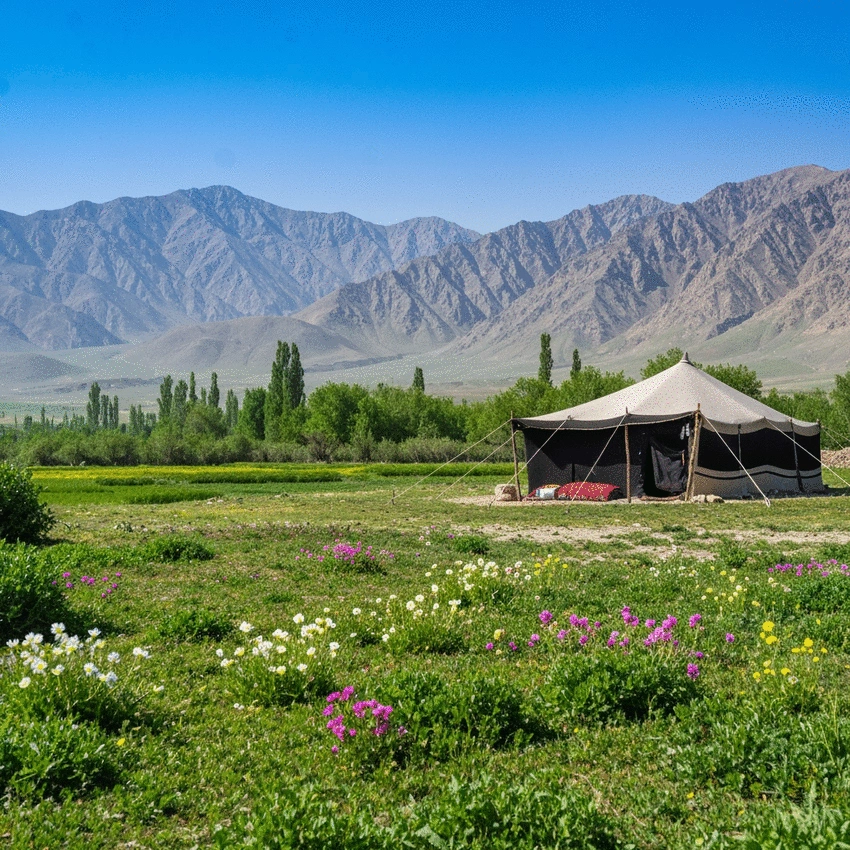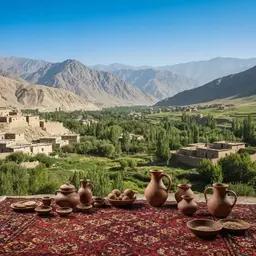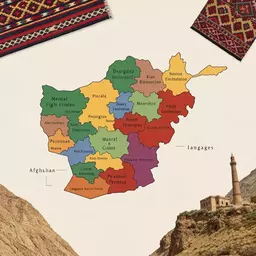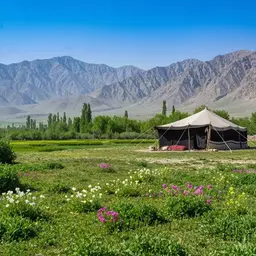Geography's Role in Afghan Culture
By Khalid Rahimi / Nov 19
When planning your journey to Afghanistan, understanding the climate and timing of your visit is crucial. Did you know that different seasons not only affect weather conditions but also local cultural events? This article will guide you through the optimal times to visit and help you make the most of your adventure!
Understanding Afghanistan's seasonal patterns is key to planning a rewarding trip, aligning your visit with favorable weather and vibrant cultural events.
Weather: Mild temperatures, blooming landscapes.
Events: Nawruz (Afghan New Year) in March.
Weather: Hot days, cool nights.
Events: Ideal for mountain trekking in June.
Weather: Vibrant foliage, pleasant climate.
Events: Harvest festivals, mesmerizing fall foliage in October.
Weather: Cold temperatures, snowy landscapes.
Events: Ideal for winter sports and cultural experiences in February.
When planning your journey to Afghanistan, understanding the climate and timing of your visit is crucial. The country's diverse geography results in a wide range of climatic conditions, which can greatly impact your travel experience. Knowing when to go can help you enjoy the breathtaking landscapes and vibrant culture while avoiding potential weather-related challenges. For up-to-date travel advisories and information on safety, it's always wise to consult official government sources such as the U.S. Department of State's travel page for Afghanistan.
Each season in Afghanistan offers unique opportunities and experiences. Whether you’re trekking through the majestic mountains or exploring cultural festivals, the right timing can make all the difference in creating unforgettable memories. Let’s delve into why timing matters for your trip and how to navigate the seasonal weather patterns.
Timing can significantly influence your travel experience in Afghanistan. Here are a few reasons why:
Being aware of these factors can help you plan a trip that aligns with your interests and enhances your overall experience in this fascinating country. Additionally, for general travel advice and further information on the country, resources like Smartraveller's guide to Afghanistan can be very helpful.
Afghanistan experiences four distinct seasons, each with its own unique charm and weather characteristics. Understanding these seasonal patterns will help you tailor your travel itinerary effectively:
As you prepare for your journey, keep these seasonal insights in mind. Each season presents its own beauty, allowing you to experience the rich cultural tapestry of Afghanistan in different ways. For additional information regarding safety measures and what to expect when traveling, consulting official government advisories such as Global Affairs Canada's travel advice for Afghanistan is highly recommended.
Now that we’ve established the significance of timing, let's break down the seasonal weather conditions in Afghanistan to help you plan your adventure effectively.
To make the most of your visit to Afghanistan, consider reaching out to local guides who can provide insights into the best times to experience cultural festivals and seasonal activities. Their local knowledge can help you uncover hidden gems and enrich your travel experience, making your journey unforgettable.
As you plan your journey to Afghanistan, it's essential to focus on the best months for travel, considering both the weather and the vibrant local events. Generally, the spring months of March to May are ideal, offering a mild climate perfect for exploring the country's rich heritage and breathtaking landscapes. Similarly, autumn from September to November showcases stunning fall colors and several cultural festivals that provide deep insights into Afghan traditions.
Here’s a quick summary of the optimal times to visit:
Finalizing your travel plans around these months allows for a richer experience, ensuring you witness both the stunning natural beauty and the lively cultural expressions of Afghanistan.
In addition to the general seasonal insights, specific months shine brightly in the calendar for travelers. For instance, March heralds the arrival of Nawruz, the Afghan New Year, celebrated with vibrant festivities. Similarly, September marks the beginning of autumn, presenting a unique opportunity to join in the harvest festivals across various provinces.
By planning your trip during these months, you not only enjoy favorable weather but also get to immerse yourself in the cultural heartbeat of Afghanistan.
As you consider your travel itinerary, remember that flexibility is key. The weather can be unpredictable, especially in mountainous regions. It's important to have a well-rounded travel plan that accommodates changes while still focusing on the core experiences you wish to enjoy. Don't hesitate to connect with locals who can offer valuable insights into the best times for specific activities.
Afghanistan is a country of stunning contrasts and captivating stories. From the bustling bazaars to the serene landscapes, every corner holds a new adventure waiting to unfold. I encourage you to explore, engage, and embrace the beauty of Afghanistan in your travels!
The best times to visit Afghanistan are generally during spring (March to May) and autumn (September to November). These seasons offer mild temperatures, beautiful landscapes, and various cultural festivals.
Key seasonal events include Nawruz (Afghan New Year) in March, mountain trekking opportunities in June, harvest festivals and fall foliage in October, and winter sports and cultural experiences in February.
Spring (March-May) has mild temperatures and blooming landscapes. Summer (June-August) features hot days and cool nights. Autumn (September-November) offers vibrant foliage and pleasant climates. Winter (December-February) brings cold temperatures and snowy landscapes.
Timing is crucial because it aligns your visit with favorable weather conditions, allows you to participate in cultural events, and ensures optimal conditions for outdoor activities like trekking or exploring historical sites.
You can engage with rich traditions and festivals like Eid, explore vibrant local markets, and savor delicious Afghan cuisine such as pilaf, kebabs, and mantu. Connecting with locals and participating in their activities offers deeper insights into the Afghan way of life.
Experiencing Afghanistan goes beyond just seeing the sights; it’s about connecting with its rich traditions and festivals. Engaging in local celebrations like Eid or the colorful harvest festivals provides a deeper understanding of the Afghan way of life. These events are perfect opportunities to meet locals, taste delicious traditional foods, and witness the cultural fabric that weaves the nation together.
Make sure to participate in activities that resonate with you. Whether it’s joining in a music festival or observing a traditional dance, these moments foster connections that can lead to lasting memories.
Don’t miss the chance to explore the vibrant local markets! Afghan cuisine is a delightful blend of flavors and aromas, with dishes like pilaf, kebabs, and the famous mantu waiting to be savored. Visiting the bazaars not only offers a taste of these culinary delights but also immerses you in the heart of Afghan culture. As you wander through the stalls filled with spices, textiles, and handcrafted goods, take the time to chat with the vendors. Their stories and insights will enrich your travel experience immensely.
As you embark on your Afghan adventure, I would love to hear about your experiences! Have you witnessed a local festival, tasted a dish that took your breath away, or explored a hidden gem? Share your stories with us, and let’s build a community that celebrates the beauty and complexity of Afghanistan together. Your journey can inspire others to discover this remarkable country and create their own unforgettable memories!
Here is a quick recap of the important points discussed in the article:

 Geography's Role in Afghan Culture
In the intricate tapestry of Afghanistan, geography plays a pivotal role in shaping cultural identit
Geography's Role in Afghan Culture
In the intricate tapestry of Afghanistan, geography plays a pivotal role in shaping cultural identit
 Understanding Afghanistan’s Provincial Demographics
Engaging with the intricate demographics of Afghanistan reveals how deeply culture and identity shap
Understanding Afghanistan’s Provincial Demographics
Engaging with the intricate demographics of Afghanistan reveals how deeply culture and identity shap
 Visiting Afghanistan: Seasonal Travel Tips
When planning your journey to Afghanistan, understanding the climate and timing of your visit is cru
Visiting Afghanistan: Seasonal Travel Tips
When planning your journey to Afghanistan, understanding the climate and timing of your visit is cru